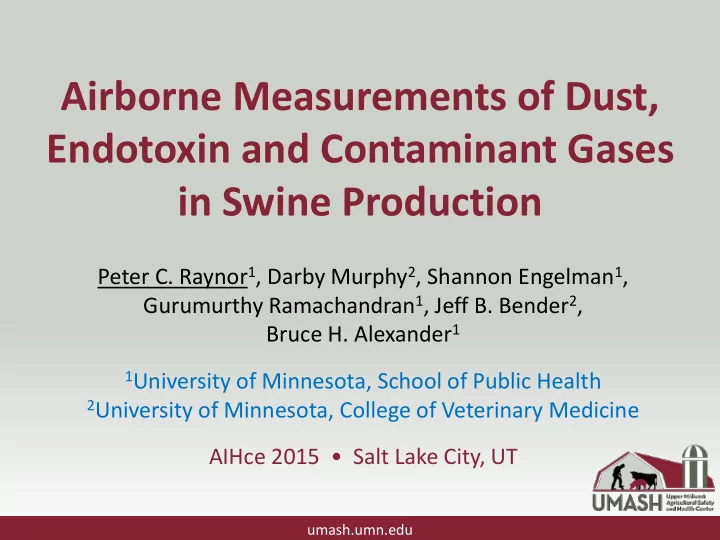

Airborne Measurements of Dust, Endotoxin and Contaminant Gases in Swine Production Peter C. Raynor 1 , Darby Murphy 2 , Shannon Engelman 1 , Gurumurthy Ramachandran 1 , Jeff B. Bender 2 , Bruce H. Alexander 1 1 University of Minnesota, School of Public Health 2 University of Minnesota, College of Veterinary Medicine AIHce 2015 • Salt Lake City, UT umash.umn.edu
Respiratory Health Concerns for Swine Workers • Airborne exposures – Ammonia – Hydrogen sulfide – Dust – Endotoxin • Asthma/reactive airway disease – Induction – Exacerbation • Chronic obstructive pulmonary disease • Susceptibility to infectious diseases umash.umn.edu
UMASH Goal Determine how changing production practices and facilities relate to worker health and safety
Production Systems Gestation Stalls Gestation Pens http://www.agrinews.com http://brownfieldagnews.com
Objectives Characterize exposure concentrations in gestation housing • Compare production systems: pens vs. stalls • Look for seasonal differences in Minnesota • Compare sow "moving" days vs. "non-moving" days • Observe tasks to see effects on concentrations
Swine Facility at SROC Gestation Stalls Gestation Pens Farrowing Finishing umash.umn.edu
When did we sample? One time each month for a year: • Simultaneous 8-hour area samples in gestation room w/ stalls & gestation room w/ pens on "moving" days • Simultaneous 8-hour area samples in gestation room w/ stalls & gestation room w/ pens on "non-moving" days • Simultaneous 8-hour area samples in finishing room w/ dry feed & finishing room w/ wet feed • Concentration mapping of main building three times in one day umash.umn.edu
For what did we sample? • Ammonia (Gray Wolf, DirectSense Electrochemical Gas Sensors) • Hydrogen sulfide (Gray Wolf, DirectSense Electrochemical Gas Sensors) • Respirable dust (37 mm PVC filters; gravimetric analysis) • Respirable endotoxin (37 mm polycarbonate filters; LAL kinetic chromogenic analysis) • Carbon dioxide (TSI, Q-Trak Models 8552/7575) • Temperature (TSI, Q-Trak Models 8552/7575) umash.umn.edu
Samplers umash.umn.edu
Pens vs. Stalls: Ammonia Moving vs. Non-Moving Days not significant Pens 30% higher on average; p = 0.055 Concentration increases during winter umash.umn.edu
Pens vs. Stalls: Hydrogen Sulfide Pens 5% higher on average; p = 0.81 umash.umn.edu
Hydrogen Sulfide (Stalls; Non-Moving) umash.umn.edu
Pens vs. Stalls: Respirable Dust Pens 43% higher on average; p = 0.023 umash.umn.edu
Pens vs. Stalls: Respirable Endotoxin Pens 67% higher on average; p = 0.00027 umash.umn.edu
Combined Exposures • Inhalation of ammonia, hydrogen sulfide, and endotoxin have similar effects on respiratory system • A way to combine the concentrations: Hazard Index = Avg NH 3 Conc 8−hr NH 3 TLV + Avg H 2 S Conc 8−hr H 2 S TLV + Endotoxin Conc DECOS HBROEL Hazard Index = Avg NH 3 Conc + Avg H 2 S Conc + Endotoxin Conc 90 EU/m 3 25 ppm 1 ppm • If Hazard Index > 1, concern warranted umash.umn.edu
Pens vs. Stalls: Hazard Index umash.umn.edu
Pens vs. Stalls: Carbon Dioxide umash.umn.edu
Pens vs. Stalls: Temperature umash.umn.edu
Summary • Season dominates most of the other factors due to ventilation • Concentrations in pens higher, on average, with varying significance • No significant difference between moving/non-moving days • Endotoxin levels are high in winter; other agents below OELs • Effects of combined exposures worth further consideration • One site in Minnesota: how generalizable? • Further characterization of exposures during power washing is warranted • Heat stress is a concern for workers as well as pigs • Could these air pollutants affect swine growth or productivity? umash.umn.edu
Acknowledgements • Staff of Southern Research and Outreach Center (SROC) • Dr. Sam Baidoo, University of Minnesota & SROC • UMASH funded by NIOSH Cooperative Agreement: U54 OH010170 umash.umn.edu
Recommend
More recommend